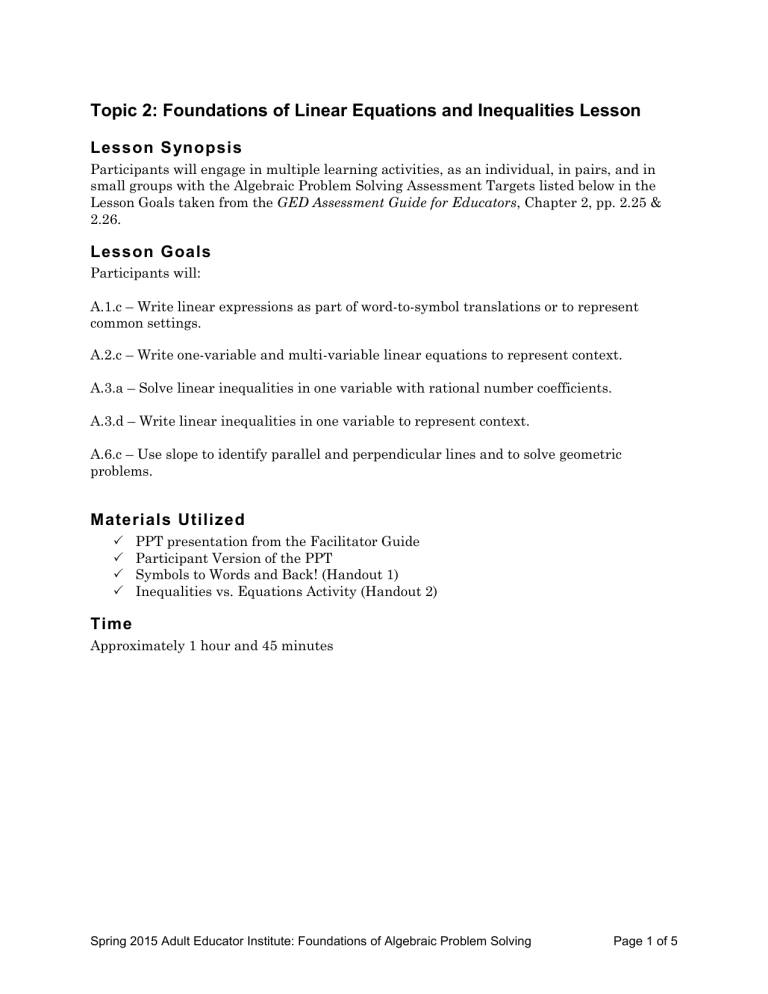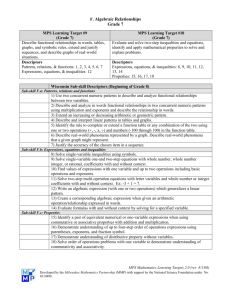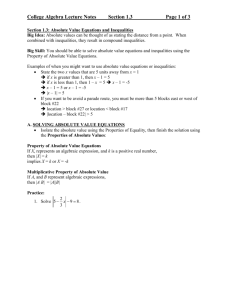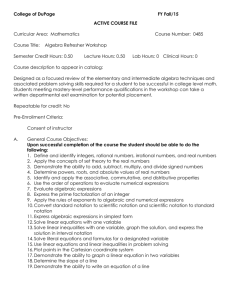Lesson Plan

Topic 2: Foundations of Linear Equations and Inequalities Lesson
Lesson Synopsis
Participants will engage in multiple learning activities, as an individual, in pairs, and in small groups with the Algebraic Problem Solving Assessment Targets listed below in the
Lesson Goals taken from the GED Assessment Guide for Educators, Chapter 2, pp. 2.25 &
2.26.
Lesson Goals
Participants will:
A.1.c – Write linear expressions as part of word-to-symbol translations or to represent common settings.
A.2.c – Write one-variable and multi-variable linear equations to represent context.
A.3.a – Solve linear inequalities in one variable with rational number coefficients.
A.3.d – Write linear inequalities in one variable to represent context.
A.6.c – Use slope to identify parallel and perpendicular lines and to solve geometric problems.
Materials Utilized
PPT presentation from the Facilitator Guide
Participant Version of the PPT
Symbols to Words and Back! (Handout 1)
Inequalities vs. Equations Activity (Handout 2)
Time
Approximately 1 hour and 45 minutes
Spring 2015 Adult Educator Institute: Foundations of Algebraic Problem Solving Page 1 of 5
Lesson Content
Part A: Introduction/Lesson Overview (5 minutes)
Discuss the purpose of this lesson; show PPT slide 3.
Slides 3: Lesson Goals
A.1.c – Write linear expressions as part of word-to-symbol translations or to represent common settings.
A.2.c – Write one-variable and multi-variable linear equations to represent context.
A.3.a – Solve linear inequalities in one variable with rational number coefficients.
A.3.d – Write linear inequalities in one variable to represent context.
A.6.c – Use slope to identify parallel and perpendicular lines and to solve geometric problems.
Explain how the session will work using slide 4.
Slide 4: Working With the Content
You will think individually at times.
You will work with a partner at times.
You will work in small groups at times.
Part B: Linear Expressions - Symbols to Words and Back (40 minutes)
Begin with discussing the key phrases on slide 5 and how they translate to the math symbols associated with the key words in the phrase.
Slide 5: Words to Symbols
Tell the participants that five posters are posted around the room with linear expressions written on them. Have them number off 1 to 5 to determine which of the posters they will start with. Tell the participants that they will have 15 seconds at each poster to brainstorm with your group members as many word phrases as you can to correctly translate the linear expression to a word phrase. When the chime rings move clockwise to the next poster and add any new phrases your can think of to what is already there.
Slide 6: Symbols to Words Activity
TCSG Adult Education
Facilitator Guide Algebraic Problem Solving: Spring 2015 Institute
After each group has had 15 seconds at each poster. Have them do a “gallery walk” and look at all the different ways that the class came up with how to write word phrases for each of the linear expressions. Then, ask them to go back to the poster they started with to reunite with their small group for the next part of the activity.
Slide 7: Words to Algebraic Expressions Activity
Use slide 7 to instruct the participants on the next part of the activity. Have the following written on five different index cards and pass out one card to each group standing at their assigned poster.
1.
the difference between twice x and y
2.
the difference between the square of x and x
3.
the quotient of 10 and the sum of 2 and a number
4.
twice the quantity of a number increased by five
5.
the quantity of six times a number, all raised to the second power
Allow each group ample time to write the word phrase on their poster and then to brainstorm the correct way to translate it into an algebraic expression. Once they have reached consensus on the correct translation, then record it under the word phrase they wrote on the poster.
When all groups are finished, have the groups rotate clockwise to each of the five posters and spend one minute at each discussing what they see and whether or not they agree with the translation. After all have rotated through, ask them to return to their seats and distribute Symbols to Words and Back! (Handout 1)
Answer any questions the participants might have about any of the translations that they have done thus far and give them an opportunity to make any notes they need to on
Handout 1.
Slides 8 & 9: Try These with a Partner!
Have the participants conduct a Think/Pair/Share with the translations from context to linear expressions with the last four problems at the bottom of Handout 1. Ask them to do them one at a time where they think and come up with an answer on their own, then, they share with their partner. Allow the pairs 3 minutes per problem and call them back to a whole group to share out answers to each problem.
TCSG Adult Education
Facilitator Guide Algebraic Problem Solving: Spring 2015 Institute
Part C: Linear Equations - Symbols to Words and Back (15 minutes)
Tell the participants that now that we have practiced translating words to algebraic expressions, that we will take it one step farther and translate words and context to linear equations. Remind them that this is GED Assessment Target A.2.c. Using slide 10, talk through the first two translations with the whole group and then ask them to work with a partner to do the last three on the slide.
Slide 10: Translating Words to Linear Equations
Now we will take it another step further and take a situation (context) and translate the information into an equation that can be solved. Introduce this with slide 11 and talk the whole class through how to arrive at the variable assignment and then the equation word phrase by word phrase.
Slide 11: Context to Linear Equations
Have the participants work in pairs to translate the situation on slide 12 to a linear equation. Then have a few pairs share out their answers and how they thought through the phrases.
Slide 12: Context to Linear Equations
Use the example on slide 13 to show a situation in which you would use what you know about linear equations to write a multi-variable linear equation to represent context.
Slide 13: Context to Multi-variable Linear Equations
Part D: Linear Inequalities
– Solving and Writing (30 minutes)
Begin the next part of the lesson by introducing one variable inequalities with this video from YouTube and the Math Dude (7 min. 14 sec.).
Slide 14: Linear Inequalities
After the video, distribute Inequalities vs. Equations Activity (Handout 2). Have the participants form groups of three and give them 15 minutes to complete the activity. Once the 15 minutes are up have three groups report out answers to 1, 4, and 5 and then discuss as a whole group the other two answers.
TCSG Adult Education
Facilitator Guide Algebraic Problem Solving: Spring 2015 Institute
Part E: Slopes of Parallel & Perpendicular Lines (15 minutes)
Use the Khan Academy Video referenced on slide 16 to introduce the content for GED
Assessment Target A.6.c. Show the video and ask students to take notes as they watch the video. (Video lasts 9 min. 13 sec.)
Slide 16: Slopes of Parallel & Perpendicular Lines
Have the participants pair up and answer the following questions from their notes.
Slides 17 & 18: Try with a Partner!
1. Describe in your own words the relationship of the slopes of parallel lines.
2. Describe in your own words the relationship of the slopes of perpendicular lines.
3. Using what you know about parallel and perpendicular lines and the relationships of their slopes and what you know about writing the equations of lines do the following:
Find the equation of the line that is perpendicular to y = -4x + 10 and passes through the point (7, 2). Leave your answer in standard form.
Find the equation of the line that is parallel to y = -4x + 10 and passes through the point (7, 2). Leave your answer in standard form.
End the morning session with slide 19 and tell the participants that they have exactly one hour for lunch and we will begin promptly at 1:00 p.m. for the afternoon session.
Slides 19: Lunch Time!
TCSG Adult Education
Facilitator Guide Algebraic Problem Solving: Spring 2015 Institute





